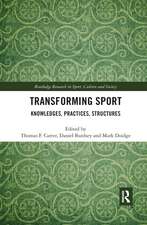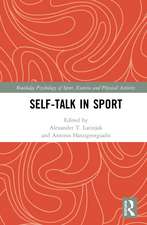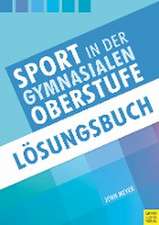Recovery and Stress in Sport: A Manual for Testing and Assessment
Autor Michael Kellmann, Sarah Köllingen Limba Engleză Paperback – 14 mar 2019
The current recovery-stress state depends on preceding stress and recovery activities, but through simultaneous assessment of stress and recovery, a differentiated picture can be provided. This manual includes two measurement instruments to gauge individual recovery, enabling both athletes and coaches to better understand the often-unconscious processes that impinge upon peak performance, and to monitor the physical, mental, emotional, mental, and overall recovery-stress state before and after training. The Acute Recovery and Stress Scale (ARSS) and the Short Recovery and Stress Scale (SRSS) are instruments that systematically enlighten the recovery-stress states of athletes. Through utilization of the ARSS and the SRSS, athletes and coaches can better understand the importance of daily activities, including how they can relate to stress/recovery and the direct impact on athletic performance.
In addition to the instruments themselves, both of which are simple and easy to use, the manual also discusses their development, their basis in theory, and case studies showcasing their usage. The ARSS and the SRSS provide important information regarding the current recovery-stress state during the process of training, and are essential tools for coaches, sport scientists, sport psychologists, and athletes alike.
| Toate formatele și edițiile | Preț | Express |
|---|---|---|
| Paperback (1) | 199.26 lei 43-57 zile | |
| Taylor & Francis – 14 mar 2019 | 199.26 lei 43-57 zile | |
| Hardback (1) | 709.04 lei 43-57 zile | |
| Taylor & Francis – 19 mar 2019 | 709.04 lei 43-57 zile |
Preț: 199.26 lei
Nou
Puncte Express: 299
Preț estimativ în valută:
38.13€ • 39.91$ • 31.73£
38.13€ • 39.91$ • 31.73£
Carte tipărită la comandă
Livrare economică 31 martie-14 aprilie
Preluare comenzi: 021 569.72.76
Specificații
ISBN-13: 9781138389533
ISBN-10: 1138389536
Pagini: 116
Ilustrații: 32 Tables, black and white
Dimensiuni: 219 x 276 x 14 mm
Greutate: 0.32 kg
Ediția:1
Editura: Taylor & Francis
Colecția Routledge
Locul publicării:Oxford, United Kingdom
ISBN-10: 1138389536
Pagini: 116
Ilustrații: 32 Tables, black and white
Dimensiuni: 219 x 276 x 14 mm
Greutate: 0.32 kg
Ediția:1
Editura: Taylor & Francis
Colecția Routledge
Locul publicării:Oxford, United Kingdom
Public țintă
Academic, Postgraduate, Professional, and Professional Practice & DevelopmentCuprins
Preface
Acknowledgments
1. Overview
2. Theory
3. Test Development
4. The Acute Recovery and Stress Scale
5. The Short Recovery and Stress Scale
6. Comparison of the ARSS and the SRSS
7. Case Studies
References
List of articles using the ARSS and/or the SRSS
Appendix
About the Authors
Acknowledgments
1. Overview
2. Theory
3. Test Development
4. The Acute Recovery and Stress Scale
5. The Short Recovery and Stress Scale
6. Comparison of the ARSS and the SRSS
7. Case Studies
References
List of articles using the ARSS and/or the SRSS
Appendix
About the Authors
Notă biografică
Michael Kellmann is Head of the Sport Psychology Unit, Faculty of Sport Science, Ruhr University Bochum, Germany, and Honorary Professor at the School of Human Movement and Nutrition Sciences, The University of Queensland, Australia
Sarah Kölling is a researcher and lecturer at the Sport Psychology Unit, Faculty of Sport Science, Ruhr University Bochum, Germany. While creating this manual, she was also holding a post-doc position at Stellenbosch University, South Africa
Sarah Kölling is a researcher and lecturer at the Sport Psychology Unit, Faculty of Sport Science, Ruhr University Bochum, Germany. While creating this manual, she was also holding a post-doc position at Stellenbosch University, South Africa
Descriere
This manual includes two measurement instruments, the Acute Recovery and Stress Scale (ARSS) and the Short Recovery and Stress Scale (SRSS), to gauge individual recovery, enabling both athletes and coaches to better understand the processes that impinge upon peak performance, and to monitor the recovery-stress state before and after training.













